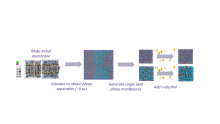The discovery of coexisting liquid-ordered and liquid-disordered phases in multicomponent lipid bilayers has received widespread attention due to its potential relevance for biological systems. One of the many open questions is how the presence of additional components affects the nature of the coexisting phases. Of particular interest is the addition of alcohols because their anesthetic properties may arise from modulating bilayer behavior. We use coarse-grained Molecular Dynamics simulations to gain insight into the partitioning preferences of linear n-alcohols into ordered and disordered bilayers alongside their effects on local membrane structure. We find that alcohols cause only small changes to membrane composition alongside a lack of significant effects on membrane thickness and lipid tail order. Cholesterol and n-alcohol trans-bilayer motion is measured and found to be near or within the range of previous atomistic results. The cholesterol flip-flop rates increase with both n-alcohol length and concentration for octanol, dodecanol, and hexadecanol, indicating a decrease in lipid order. Umbrella sampling simulations of removing cholesterol from tertiary membranes find no significant difference with or without n-alcohols at various concentrations. Simulations of a phase-separated bilayer show that octanol preferentially partitions into the liquid-disordered phase in a ratio of approximately 3:1 over the liquid-ordered phase. Furthermore, partition coefficients of alcohol in single-phase membranes show a preference for longer alcohols (dodecanol and hexadecanol) to partition preferentially into the liquid-ordered phase, while decreasing the length of the alcohol reverses this trend. Our work tests experimental results while also investigating the ability for coarse-grained MARTINI simulations to capture minute differences in model membrane spatial arrangements on the nanoscale level.
